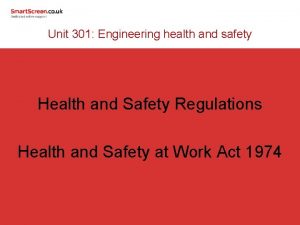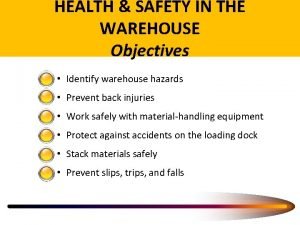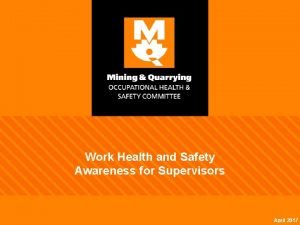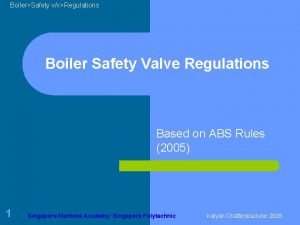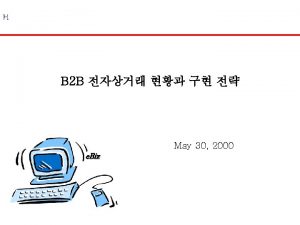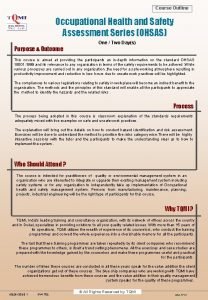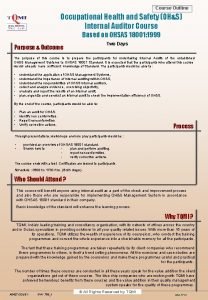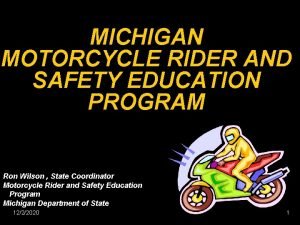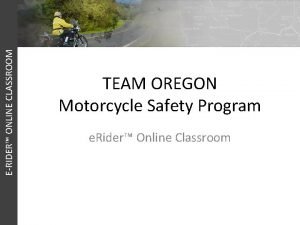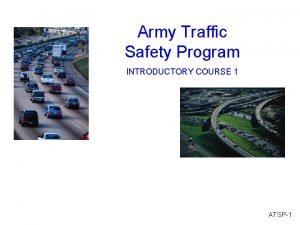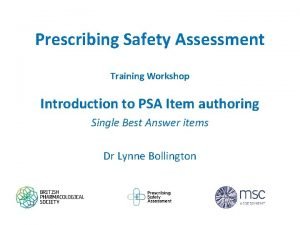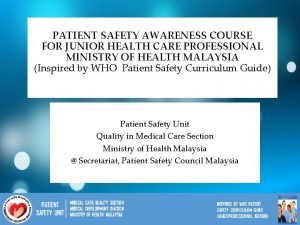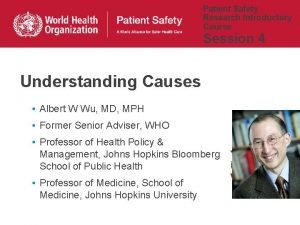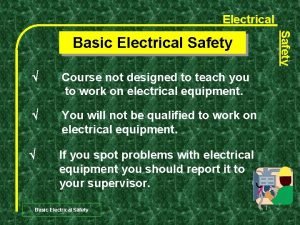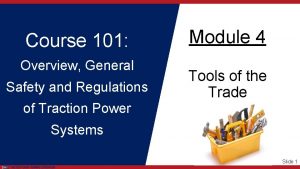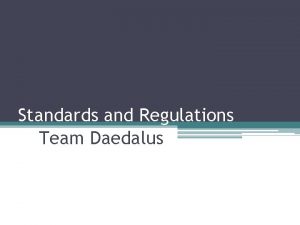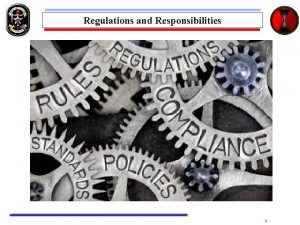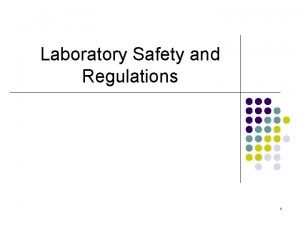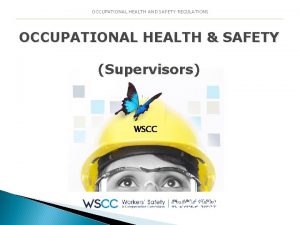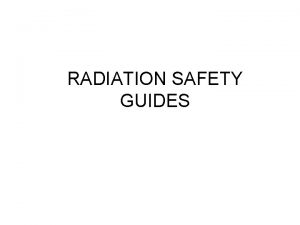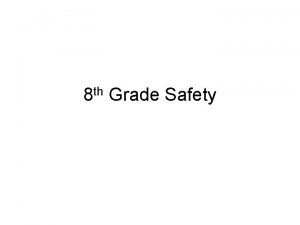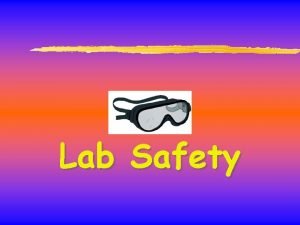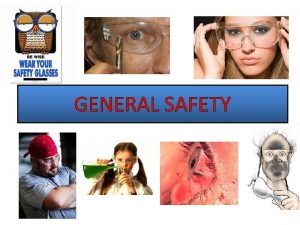Course 101 Overview General Safety and Regulations of










![Knowledge Check [Matching] Match the symptoms to the scale: Ventricular fibrulation Difficulty breathing Muscular Knowledge Check [Matching] Match the symptoms to the scale: Ventricular fibrulation Difficulty breathing Muscular](https://slidetodoc.com/presentation_image_h2/c069720c484ebf42c322d95edcc9cd20/image-11.jpg)



![Knowledge Check [Image] Item 1 Item 2 Which items, if any, are shown in Knowledge Check [Image] Item 1 Item 2 Which items, if any, are shown in](https://slidetodoc.com/presentation_image_h2/c069720c484ebf42c322d95edcc9cd20/image-15.jpg)
![Learning Application [Case Study] Question 1 Text According to OSHA what Item are arc-flash Learning Application [Case Study] Question 1 Text According to OSHA what Item are arc-flash](https://slidetodoc.com/presentation_image_h2/c069720c484ebf42c322d95edcc9cd20/image-16.jpg)


![Knowledge Check [True/False] You should be a hero in case of an emergency. TRUE Knowledge Check [True/False] You should be a hero in case of an emergency. TRUE](https://slidetodoc.com/presentation_image_h2/c069720c484ebf42c322d95edcc9cd20/image-19.jpg)


![Learning Application [Video] Question 1 Text Item 1 Item 3 Item 4 Task 1 Learning Application [Video] Question 1 Text Item 1 Item 3 Item 4 Task 1](https://slidetodoc.com/presentation_image_h2/c069720c484ebf42c322d95edcc9cd20/image-22.jpg)
![Learning Application [Discussion] Question Text What are 1 some standard practices in your agency Learning Application [Discussion] Question Text What are 1 some standard practices in your agency](https://slidetodoc.com/presentation_image_h2/c069720c484ebf42c322d95edcc9cd20/image-23.jpg)

![Lock Out/Tag Out [LOTO] LOTO: All individuals working on a secured circuit have their Lock Out/Tag Out [LOTO] LOTO: All individuals working on a secured circuit have their](https://slidetodoc.com/presentation_image_h2/c069720c484ebf42c322d95edcc9cd20/image-25.jpg)
![Personal Protective Equipment [PPE] Refers to protective clothing, helmets, goggles, or other garment or Personal Protective Equipment [PPE] Refers to protective clothing, helmets, goggles, or other garment or](https://slidetodoc.com/presentation_image_h2/c069720c484ebf42c322d95edcc9cd20/image-26.jpg)


- Slides: 28

Course 101: Overview, General Safety and Regulations of Traction Power Module 2 Major Safety Concerns and Standard Practices Systems Slide 1

Review Slide: Module 1 Overview Traction Power Basics Modes of Traction Power Health & Safety Slide 2

Module 2 Learning Objectives Identify the major safety concerns for traction power systems and their respective avoidance or prevention methods Identify High Voltage safety basics and prevention techniques Identify Arc Flash hazards, safety and prevention methods Identify burn avoidance and prevention methods Recall the standard safety practices and methods for reducing hazardous conditions such as LOTO, removing power and zero energy states, and handling electrical equipment Recall the steps for emergency response and preparedness for traction power hazards? Identify proper general personal protective equipment [PPE] for use in a traction power system Slide 3

Section One: Overview Slide 4

Safety & Regulations Safety regulation and procedures can vary between agencies, but all take into account oversight from federal and state regulation. At a local level, each agency can have differences in the manner in which they operate, and have different systems in place that warrant another approach for inspection, maintenance and troubleshooting. For this section the federal and state level organizations will be addressed in regards to safety precautions and procedures. Slide 5

Section Two: Major Safety Concerns Slide 6

Electrical Safety An electrically safe condition shall be achieved by completing all of the following: • • • Determine all sources of electrical supply (drawings, diagrams). Open disconnecting device for each source. Visually verify all blades of disconnecting devices are fully open or drawout-type breakers are withdrawn. Apply lockout/tagout devices in accordance with policy. Test each phase conductor using an adequately rated voltage detector. Ground phase conductors where the possibility exists for induced or stored energy. Slide 7

Effects of Electrocution: Electrical injuries consist of four main types: • Electrocution • Electric shock • Burns • Falls caused as a result of contact with electrical energy “ The NEC describes high voltage as greater than 600 volts Standard utilization voltages produce currents passing through a human body in the milliampere (m. A) range (1, 000 m. A=1 Amp). Estimated effects of 60 Hz AC currents that pass through the chest are shown in Slide 8

High Voltage Safety: “High voltage” is a relatively arbitrary term, used to refer to electrical energy large enough to cause damage to humans. Various agencies and organizations have their own definition. The International Electrotechnical Commission adopted the following thresholds: > 1000 Vrms for AC power > 1500 V for DC power 5 m. A is enough to induce reflexive action loss of muscular control. In AC systems this can prevent the victim from being able to let go of an energized surface. 75 m. A can cause ventricular fibrillation of the heart (a rapid, ineffective heartbeat) and, ultimately, death 100 J is enough to stop (or start) a heart. 1000 J can blow of entire body parts [see chart] Slide 9

Video Text Box Slide 10
![Knowledge Check Matching Match the symptoms to the scale Ventricular fibrulation Difficulty breathing Muscular Knowledge Check [Matching] Match the symptoms to the scale: Ventricular fibrulation Difficulty breathing Muscular](https://slidetodoc.com/presentation_image_h2/c069720c484ebf42c322d95edcc9cd20/image-11.jpg)
Knowledge Check [Matching] Match the symptoms to the scale: Ventricular fibrulation Difficulty breathing Muscular paralysis Possible death Slide 11

Arc Flash Safety: An arc flash is a phenomenon where a flashover of electric current leaves its intended path and travels through the air from one conductor to another, or to ground. The results are often violent and if a human is within a close proximity to the arc flash serious injury and possibly death can occur. Arc flashes create electricity arcs - a flow of electrons through a gas, such as air. These arcs may connect to a victim or other equipment supplying an alternative path to ground. Direct contact and arcing injuries produce similar effects. Arc flashes may result in an electrical explosion known as an arc blast that results from a low impedance connection to ground or another voltage phase Slide 12

Burn Safety & Prevention: Burns at the point of contact with electrical energy can be caused by arcing to the skin, heating at the point of contact by a high resistance contact, or higher voltage currents. Contact with a source of electrical energy can cause external as well as internal burns. Flash burns and flame burns are actually thermal burns. In these situations, electrical current does not flow through the victim and injuries are often confined to the skin. Slide 13

Video Text Box Slide 14
![Knowledge Check Image Item 1 Item 2 Which items if any are shown in Knowledge Check [Image] Item 1 Item 2 Which items, if any, are shown in](https://slidetodoc.com/presentation_image_h2/c069720c484ebf42c322d95edcc9cd20/image-15.jpg)
Knowledge Check [Image] Item 1 Item 2 Which items, if any, are shown in the picture that are arc flash hazards? Item 3 Item 4 Slide 15
![Learning Application Case Study Question 1 Text According to OSHA what Item are arcflash Learning Application [Case Study] Question 1 Text According to OSHA what Item are arc-flash](https://slidetodoc.com/presentation_image_h2/c069720c484ebf42c322d95edcc9cd20/image-16.jpg)
Learning Application [Case Study] Question 1 Text According to OSHA what Item are arc-flash 1 by? events caused What details helped create a safer environment to reduce arc flashes? Item 2 Item 3 Item 4 Document Hyperlink Text Slide 16

Emergency Preparedness: Arc Flash • The blast can even throw victims great distances, resulting in broken bones, concussions and internal injuries. Hearing loss can also result • If an arc flash occurs and the victim is still in contact with the source of electricity, do not touch the person • Never tell a conscious victim to move, as neck or spine injuries may have occurred as well. Attempting to move them could make injuries more severe. Check to see if they are breathing and if they have a pulse. If the victim is not breathing or does not have a pulse, you may need to begin CPR Slide 17

Emergency Preparedness: Electrocution • If you see someone lying unconscious or "froze on the circuit, " the very first thing to do is shut off the power by opening the appropriate disconnect switch or circuit breaker. • If someone touches another person being shocked, there may be enough voltage dropped across the body of the victim to shock the would-be rescuer, thereby "freezing" two people instead of one. • Do not be a hero. Electrons don't respect heroism. Make sure the situation is safe for you to step into, or else you will be the next victim, and nobody will benefit from your efforts. Slide 18
![Knowledge Check TrueFalse You should be a hero in case of an emergency TRUE Knowledge Check [True/False] You should be a hero in case of an emergency. TRUE](https://slidetodoc.com/presentation_image_h2/c069720c484ebf42c322d95edcc9cd20/image-19.jpg)
Knowledge Check [True/False] You should be a hero in case of an emergency. TRUE FALSE Slide 19

Safety Practices Removing Power: If at all possible, shut off the power to a circuit before performing any work on it. You must secure all sources of harmful energy before a system may be considered safe to work on. In industry, securing a circuit, device, or system in this condition is commonly known as placing it in a de-energized or zero energy state. Securing something in a zero energy state means ridding it of any sort of potential or stored energy, including but not limited to: • Dangerous voltage • Spring pressure • Hydraulic (liquid) pressure • Pneumatic (air) pressure • Suspended weight • Chemical energy (flammable or otherwise reactive substances) • Nuclear energy (radioactive or fissile substances) Slide 20

Safety Practices Cords & Equipment: • • Electrical cords and air lines should be free of loops and kinks when in use and shall be properly stored after use. Extension cords and electrical cables passing through work areas, walkways, or passageways should be covered or elevated to protect them from physical damage that would create a hazard to employees or the public. Worn, frayed or defective electrical cords should not be used and must be recycled. All extension cords and cords to portable electrical equipment and tools should be provided with ground fault circuit interrupters when used in damp or wet locations. All waterproof covers of electrical receptacles should be closed when not in use. Employees should disconnect receptacle plugs by grasping the plug and not pulling the cord. Portable extension lights should be inspected before use. Lamp guards should be used on all extension lamps and non-metallic lamp guards should be used where there is a possibility of contact with exposed electrical circuits. Slide 21
![Learning Application Video Question 1 Text Item 1 Item 3 Item 4 Task 1 Learning Application [Video] Question 1 Text Item 1 Item 3 Item 4 Task 1](https://slidetodoc.com/presentation_image_h2/c069720c484ebf42c322d95edcc9cd20/image-22.jpg)
Learning Application [Video] Question 1 Text Item 1 Item 3 Item 4 Task 1 Text Slide 22
![Learning Application Discussion Question Text What are 1 some standard practices in your agency Learning Application [Discussion] Question Text What are 1 some standard practices in your agency](https://slidetodoc.com/presentation_image_h2/c069720c484ebf42c322d95edcc9cd20/image-23.jpg)
Learning Application [Discussion] Question Text What are 1 some standard practices in your agency Item 1 for safety? Why is LOTO important? Item 2 Item 3 Item 4 Are there other rules for using extension cords during maintenance? Slide 23

Safety Practices Bucket Truck Common Hazards: • Strains and injuries caused by improper lifting and climbing injuries • Falls from as little as five feet, which can result in broken bones • Tip-overs and collapses, endanger personnel in the bucket and on the ground • Being struck by falling objects (mostly endangers workers on the ground) • Getting caught between equipment and fixed structures (especially fingers) • Being knocked out of a bucket when the truck is struck by another vehicle • Electrocution or physical injury due to electric shock Slide 24
![Lock OutTag Out LOTO LOTO All individuals working on a secured circuit have their Lock Out/Tag Out [LOTO] LOTO: All individuals working on a secured circuit have their](https://slidetodoc.com/presentation_image_h2/c069720c484ebf42c322d95edcc9cd20/image-25.jpg)
Lock Out/Tag Out [LOTO] LOTO: All individuals working on a secured circuit have their own personal padlock or combination lock that they set on the control lever of a disconnect device prior to working on the system. Additionally, they must fill out and sign a tag that they hang from their lock describing the nature and duration of the work they intend to perform on the system Slide 25
![Personal Protective Equipment PPE Refers to protective clothing helmets goggles or other garment or Personal Protective Equipment [PPE] Refers to protective clothing, helmets, goggles, or other garment or](https://slidetodoc.com/presentation_image_h2/c069720c484ebf42c322d95edcc9cd20/image-26.jpg)
Personal Protective Equipment [PPE] Refers to protective clothing, helmets, goggles, or other garment or equipment designed to protect the wearer's body from: • injury by blunt impacts, • electrical hazards, • heat, chemicals, • infection, Used for job-related occupational safety and health purposes Slide 26

Rating Scales Slide 27

Lockout/tagout : When working on a system in a deenergized or zero energy state, the worker places a personal padlock or combination lock on every energy disconnect device relevant to his or her task on that system. A tag is hung on every one of those locks describing the nature and duration of the work to be done, and who is doing it. Victims need immediate medical response: check for breathing and pulse, then apply CPR as necessary to maintain oxygenation. If a victim is still conscious after having been shocked, they need to be closely monitored and cared for until trained emergency response personnel arrive. There is danger of physiological shock, so keep the victim warm and comfortable. Slide #
 Health and safety regulations in engineering
Health and safety regulations in engineering Six pack health and safety regulations
Six pack health and safety regulations Warehouse health and safety requirements
Warehouse health and safety requirements Food safety regulations and standards
Food safety regulations and standards Health and safety six pack regulations
Health and safety six pack regulations Work health and safety act 2012 sa
Work health and safety act 2012 sa Blood safety and quality regulations
Blood safety and quality regulations Canada motor vehicle safety act
Canada motor vehicle safety act Boiler accumulation test
Boiler accumulation test Army motor pool regulations
Army motor pool regulations General overview
General overview Course title and course number
Course title and course number Occupational health and safety assessment series
Occupational health and safety assessment series Occupational health and safety course outline
Occupational health and safety course outline Flemish bond t junction
Flemish bond t junction Course interne moyenne externe
Course interne moyenne externe Disadvantages of act of parliament
Disadvantages of act of parliament Ahrs army
Ahrs army Tractor safety course oregon
Tractor safety course oregon Leader safety course module 2 answers
Leader safety course module 2 answers Motorcycle safety course michigan
Motorcycle safety course michigan Erider oregon
Erider oregon Army traffic safety introductory course
Army traffic safety introductory course Psa forklift course
Psa forklift course Patient safety goals - awareness course
Patient safety goals - awareness course Osa online safety
Osa online safety Nevada boating safety course
Nevada boating safety course Army traffic safety introductory course
Army traffic safety introductory course Basic electrical safety
Basic electrical safety
